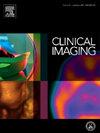Fluoroscopy in pediatric radiology: Review of current use and alternatives
IF 1.8
4区 医学
Q3 RADIOLOGY, NUCLEAR MEDICINE & MEDICAL IMAGING
引用次数: 0
Abstract
Fluoroscopy has long been an essential imaging modality in pediatric radiology. However, concerns about radiation exposure in children and the need for on-site staff have led to a decline in its use and the exploration of alternative imaging techniques. Data from the Pediatric Health Information System and our institution show a decrease in fluoroscopic studies among pediatric inpatients, from 56,371 per year (2017–2020) to 46,973 per year (2020−2023). Alternative modalities such as endoscopy, ultrasound, and computed tomography demonstrate promise in assessing conditions of the respiratory, gastrointestinal, and urinary systems. Although fluoroscopy remains valuable in certain scenarios, these alternative imaging modalities offer advantages in terms of diagnostic accuracy, accessibility, costs, and reduced radiation exposure. However, the final choice of imaging technique should be based on careful consideration of the specific clinical context, patient factors, and available resources. In this review, we present institutional and national trends on the utilization of fluoroscopic studies over the past years, along with a side-by-side comparison of traditional fluoroscopic studies commonly performed in children and newer alternative modalities.
求助全文
约1分钟内获得全文
求助全文
来源期刊

Clinical Imaging
医学-核医学
CiteScore
4.60
自引率
0.00%
发文量
265
审稿时长
35 days
期刊介绍:
The mission of Clinical Imaging is to publish, in a timely manner, the very best radiology research from the United States and around the world with special attention to the impact of medical imaging on patient care. The journal''s publications cover all imaging modalities, radiology issues related to patients, policy and practice improvements, and clinically-oriented imaging physics and informatics. The journal is a valuable resource for practicing radiologists, radiologists-in-training and other clinicians with an interest in imaging. Papers are carefully peer-reviewed and selected by our experienced subject editors who are leading experts spanning the range of imaging sub-specialties, which include:
-Body Imaging-
Breast Imaging-
Cardiothoracic Imaging-
Imaging Physics and Informatics-
Molecular Imaging and Nuclear Medicine-
Musculoskeletal and Emergency Imaging-
Neuroradiology-
Practice, Policy & Education-
Pediatric Imaging-
Vascular and Interventional Radiology
 求助内容:
求助内容: 应助结果提醒方式:
应助结果提醒方式:


